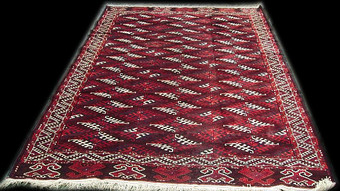Semi-antique handmade oriental rug No. 58373 Turkmen, ca. 1970 Iran 313 x 220 cm

Larger images (will open in new window)
Please click on the thumbnails below for a larger view
| main view |
view from opposite side |
 |
 |
| Item Number: |
58373 |
| Name: |
Turkmen, ca. 1970 |
| Country of Origin: |
Iran |
| Size: |
313 x 220 cm |
| Made:
|
ca. 1970 |
| Pile: |
wool |
| Design: |
geometric / allover |
| Ground Color: |
red |
| Knots per sqm: |
400,000 |
| Remarks: |
This is a unique handmade / hand-knotted / traditional oriental carpet
The pile of this carpet is made of wool
This carpet is in perfect condition despite its age
This carpet has a total of approximately 2,756,000 knots and it took skilled carpet makers about 3,675 hours or 408 working days to hand-knot this carpet. |
 add to cart
add to cart
More about the provenance Turkmen, ca. 1970 | Iran
The Turkmens are a nomadic people, which since centuries live in the region between the Caspic Sea, Amu-Darja, the Aral-Sea, the North Afghan as well as the North Persian area. Their warrior like way of life - especially in the 19th century - gained them fear and respect amongst their neighbors, but they reached real appreciation through their outstanding carpet weaving arts. Today most Turkmens settled down and don't lead nomadic lives anymore, which did not reduce the quality and art of their rugs.
This is an Oriental nomadic rug. The word "nomad" comes from the Greek word "nemein". Nomads are wandering tribes, shepherds, stockbreeders, or hunters. In the minorly populated areas of Asia and North Africa they move with their herds, all their belongings and their tents to new places constantly. Many states already tried to make them settle down with various success. Mostly it is the women of the tribes which contribute to the family's income with their carpet knotting and weaving while the men breed stock or go hunting. But due to the circumstances of nomadic life the carpet production often lacks regularity and precision in form and design, which actually adds to their originality and makes them even more popular. The wool is mostly dyed with vegetable dyes.

